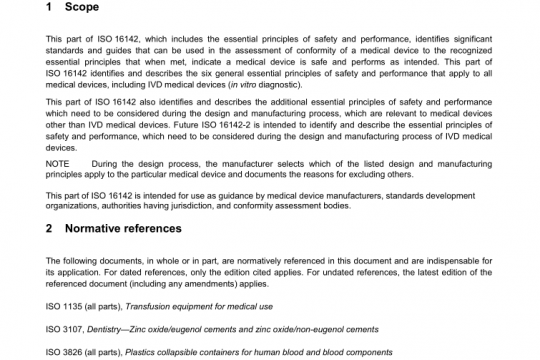ANSI AAMI DF39 pdf free download
ANSI AAMI DF39 pdf free download.Automatic external defibrillators and remote-control defibrillators.
2 Normative references and definitions 2.1 Normative references The following documents contain provisions which, through reference in this text, constitute provisions of this standard. At the time of publication, the editions indicated were valid. All standards are subject to revision, and parties to agreements based on this standard are encouraged to use the most recent editions of the documents indicated below. 2.1.1 ASSOCIATION FOR THE ADVANCEMENT OF MEDICAL INSTRUMENTATION. Cardiac defibrillator devices. ANSI/AAMI DF2—1989. Arlington (Vir.): AAMI, 1989. American National Standard. 2.1.2 ASSOCIATION FOR THE ADVANCEMENT OF MEDICAL INSTRUMENTATION. Design, testing and reporting of performance results of automatic external defibrillators. AAMI TIR2—1987. Arlington (Vir.): AAMI, 1987. Technical Information Report. 2.1.3 ASSOCIATION FOR THE ADVANCEMENT OF MEDICAL INSTRUMENTATION. Disposable ECG electrodes. ANSI/AAMI EC12—1991. Arlington (Vir.): AAMI, 1991. American National Standard. 2.1.4 ASSOCIATION FOR THE ADVANCEMENT OF MEDICAL INSTRUMENTATION. Safe current limits for electromedical apparatus. ANSI/AAMI ES1—1985. Arlington (Vir.): AAMI, 1985. American National Standard.2.1.7 INTERNATIONAL ELECTROTECHNICAL COMMISSION (IEC). Medical electrical equipment, Part 2: Particular requirements for the safety of cardiac defibrillators and cardiac defibrillator/monitors. (IEC 601-2-4). Geneva: IEC, 1983. 2.1.8 INTERNATIONAL SPECIAL COMMITTEE ON RADIO INTERFERENCE. Limits and methods of measurement of electromagnetic disturbance characteristics of industrial, scientific and medical (ISM) radio frequency equipment. (CISPR 11, 2nd edition). CISPR, 1990. (Available from ANSI.) 2.2 Definitions For the purpose of this standard, the following definitions apply: 2.2.1 automatic external defibrillator (AED): A defibrillator that analyzes the cardiac rhythm, identifies shockable rhythms, and includes logic circuitry to automatically operate the defibrillator when a shockable rhythm (ventricular fibrillation [VF] and certain forms of ventricular tachycardia [VT]) are detected. 2.2.2 event documentation: A sufficiently detailed record of events and activities surrounding an episode of cardiac arrest and attempted defibrillation or pacing. The record, which includes ECG traces and may include voice recording, allows a retrospective analysis of the event for purposes of medical control, quality assurance, and further operator training. 2.2.3 external defibrillation: The application of a high-energy, short-duration electrical discharge to the heart (myocardium) by means of electrodes placed on the body surface at appropriate locations, in an attempt to terminate VF and restore an organized, perfusing cardiac rhythm.2.2.4 external transcutaneous pacer: A device that may analyze the ECG and that delivers pacing pulses to the heart, at a controllable rate and current, by means of electrodes placed on the body surface. 2.2.5 pacing: The application of moderate-energy, very short-duration pulses to the heart, at a controlled current and frequency, to achieve cardiac contractions of appropriate strength and rate in case of complete AV block or extreme bradycardia. In transcutaneous external pacing, electrodes placed on the body surface are used to sense the cardiac rhythm and to deliver the pacing pulses. 2.2.6 remote-control defibrillator (RCD): A defibrillator that is connected by a communication link (usually a landline telephone) to a medical response center, and that is remotely controlled and operated from the response center. See section 3.5 for detailed definitions of RCDs and communication links. 2.2.7 rhythm recognition detector: An algorithm that analyzes the ECG and identifies the cardiac rhythm. The algorithm in an AED is designed for maximum sensitivity and specificity for the detection of VF. 2.2.8 secondary detector systems: Sensors for algorithms which may be used, in addition to ECG analysis, to increase the sensitivity and specificity of cardiac arrest detection by the AED. An example is the opharyngeal airway electrode which was used by Cardiac Resuscitator Corporation in the early 1980s to detect gag reflex and breathing.ANSI AAMI DF39 pdf download.
Other IEC Standards
-

ANSI AAMI ISO 16142-1 pdf free download – non-IVD medical devices and guidance on the selection of standards
AAMI standards list DOWNLOAD -

ANSI AAMI ISO 16142-2 pdf free download – General essential principles and additional specifc essential principles
AAMI standards list DOWNLOAD


